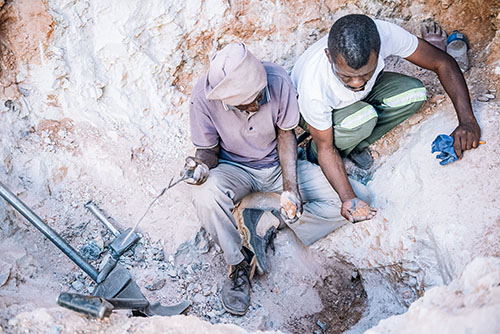Maihapa Ndjavera
Trade minister Lucia Iipumbu stated that more than 90% of the gemstones leave Namibia in a rough form, which translates into a loss of jobs and revenue for the domestic economy. Gemstones are precious or semi-precious stones that, once cut and polished, are used in jewellery.
“Data has proved that the Namibian economy depends primarily on the mining sector; therefore, since independence, government has deliberately set to incentivise value addition and manufacturing, which is a key objective in the Growth at Home Execution Strategy,” said Iipumbu on Wednesday at the graduation ceremony for gemstone students for 2021 and 2022. The graduation is the first kind to be held by the ministry.
Namibia has struggled with a high youth unemployment rate, high levels of poverty and inequality, thus local value addition remains imperative. The mining industry currently accounts for about 10% of gross domestic product (GDP), 40% of export revenue and 7% of annual government revenue.
Gemstones cutting and polishing training takes place every year for six months at the trade ministry’s Karibib Gemstones Centre in the Erongo region. This training, said Iipumbu, is one of the ministry’s key interventions, rolled to ensure the creation of a viable and sustainable entrepreneurship ecosystem.
“The above-mentioned training has been brought into effect due to the variety of semi-precious stones that are normally produced by the small-scale miners who dig and sell them to local buyers and tourists. Small-scale mining, as a sub-sector of the mining sector, provides a livelihood to a quite number of people and their families, alleviating poverty and improving lives. In addition, small-scale mining activities provide numerous job opportunities to various rural communities in Namibia, especially in regions endowed with gemstones,” the trade minister explained while handing over 44 graduation certificates.
The Karibib centre has so far trained a total of 142 beneficiaries, of which 138 graduates have completed the training programme. Furthermore, the ministry, through this centre, facilitated the placement of at least 95% of the trainees into the diamond industry.
Iipumbu remained confident that it is only through these kinds of interventions that Namibia can transform the structure of the local economy when government prioritises the most productive and efficient economic activities and local industries, as this provides well-improved market access at home and abroad.
“Producing many graduates of this course is an important element of the war against poverty and a further step on Namibia’s path towards becoming a highly competitive and industrialised nation in gemstone cutting and polishing with a sustainable economic growth plan as depicted in Vision 2030,” the minister concluded.
Meanwhile, President Hage Geingob during his maiden visit in November last year at the national diamond marketing and sales company, Namib Desert Diamonds (Namdia) headquarters, said through Namdia, government can bolster its efforts and draw investments that further promote value addition and beneficiation within the diamond industry.
At the time, Namdia board chairperson Bryan Eiseb said starting this year, the company will give preference to entities that add value to Namibian diamonds.
“We need to exploit these opportunities to create jobs and add local content and value to Namibian diamonds,” he said.


